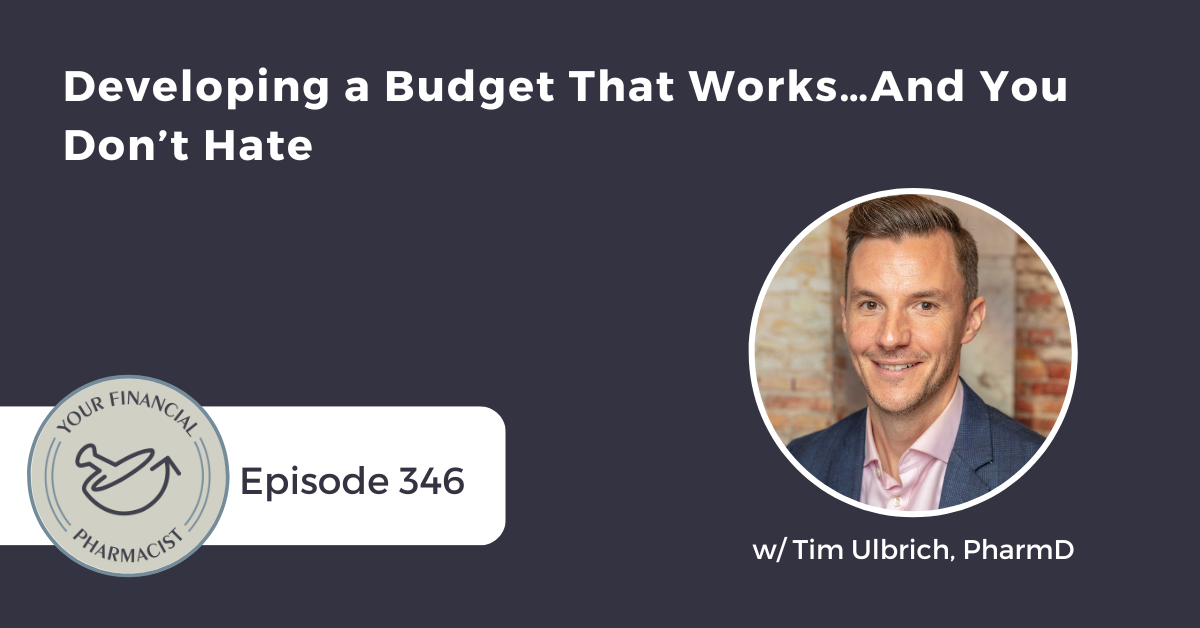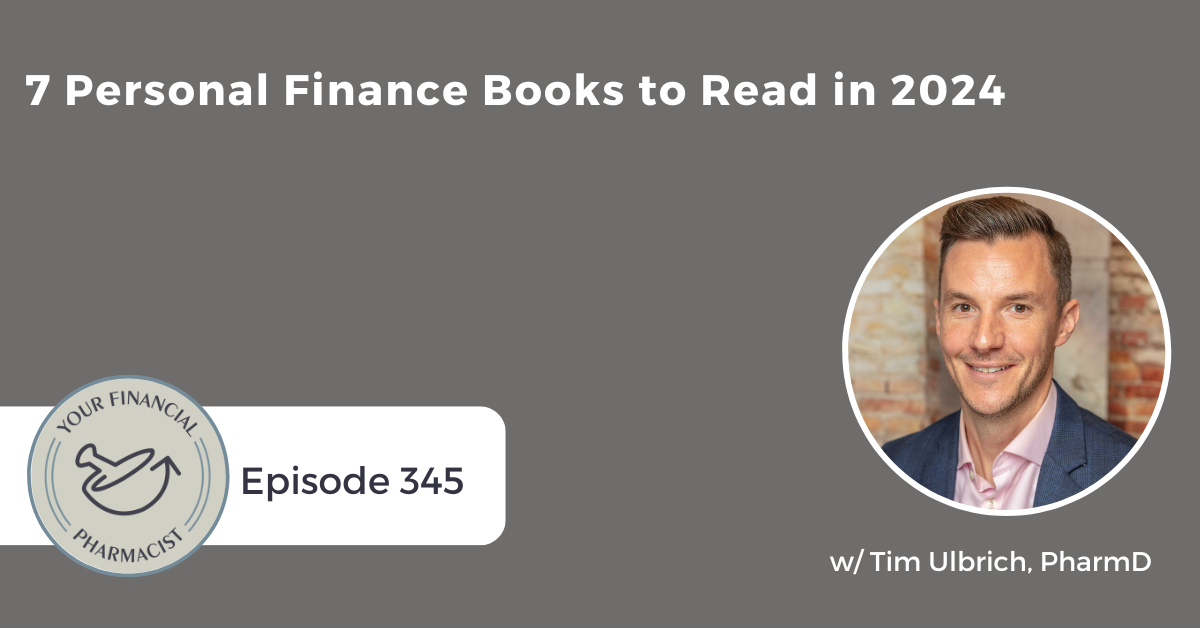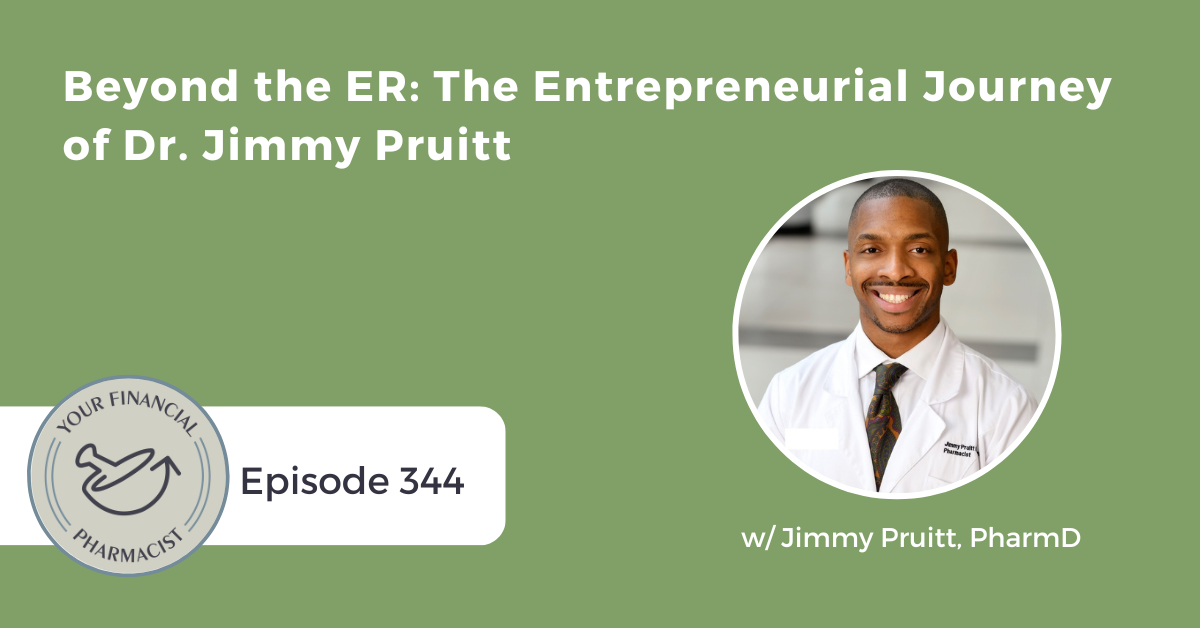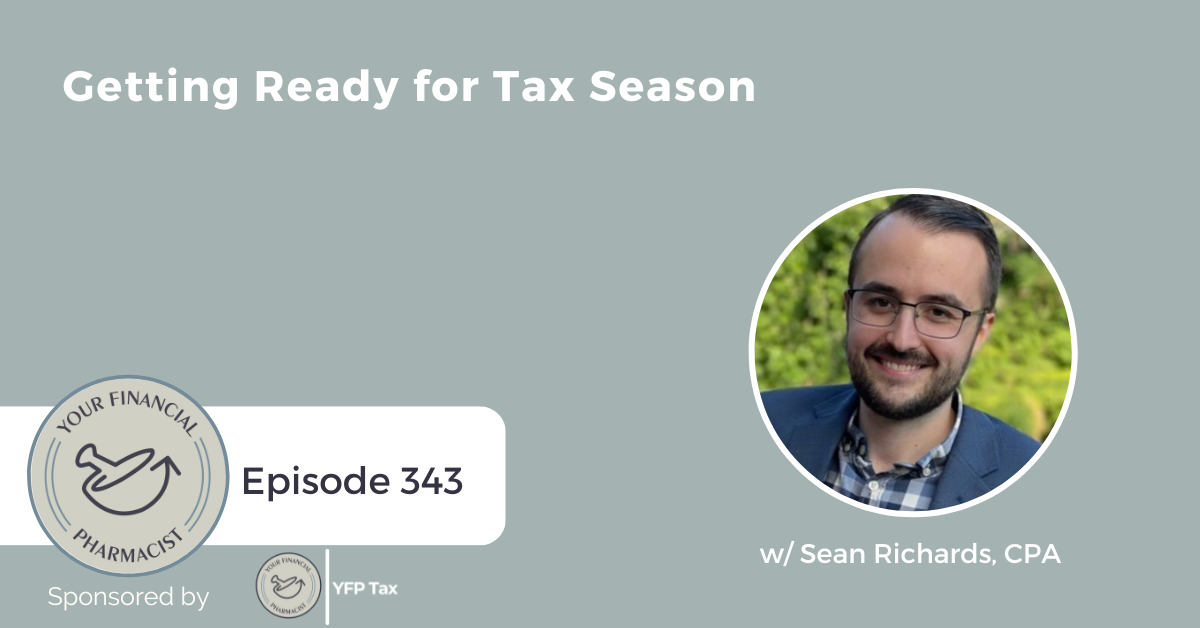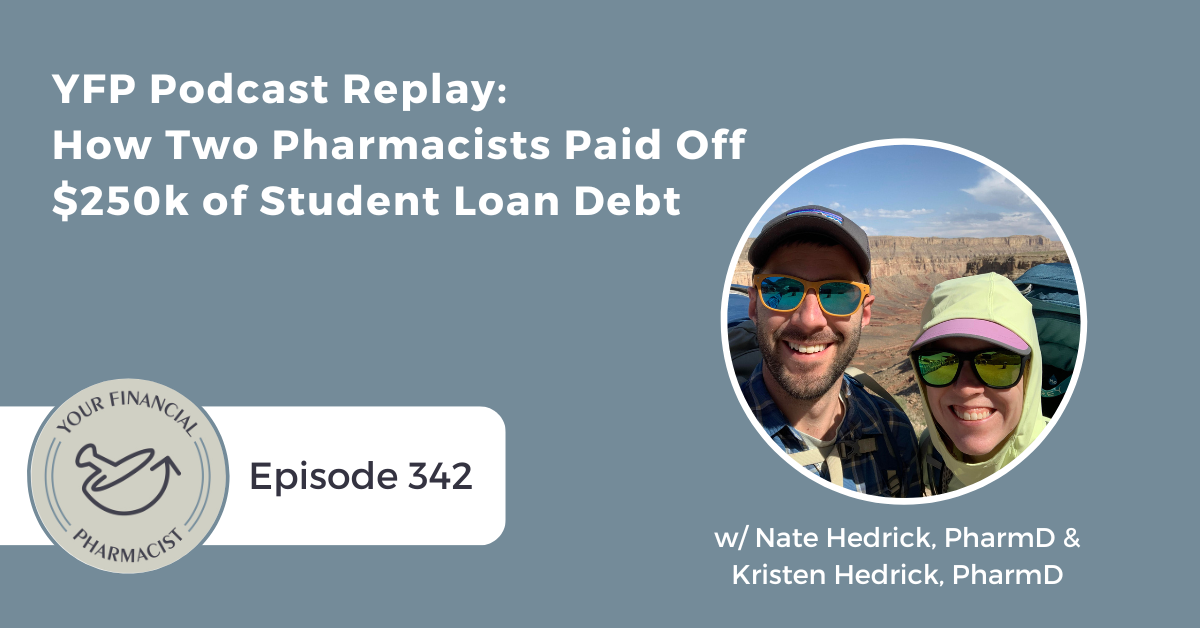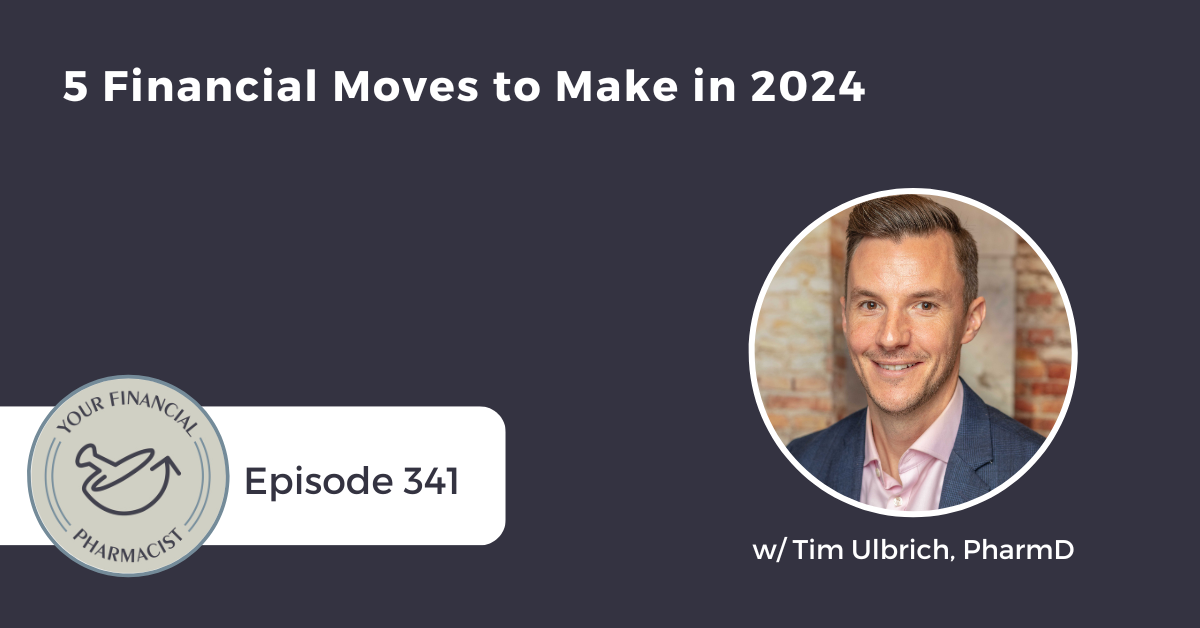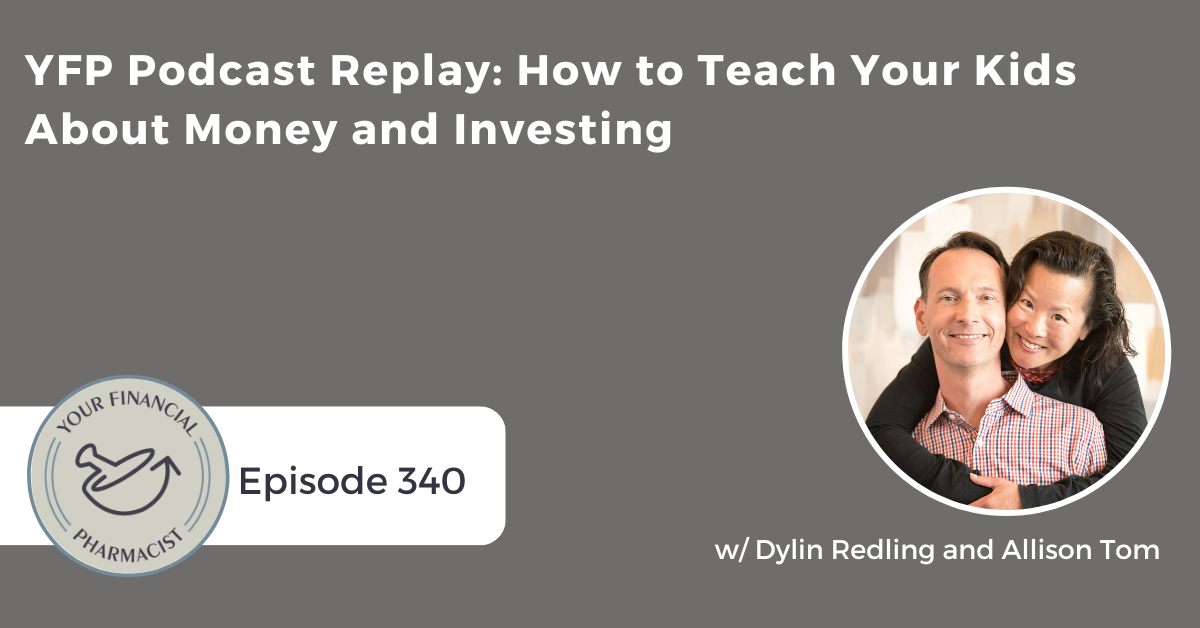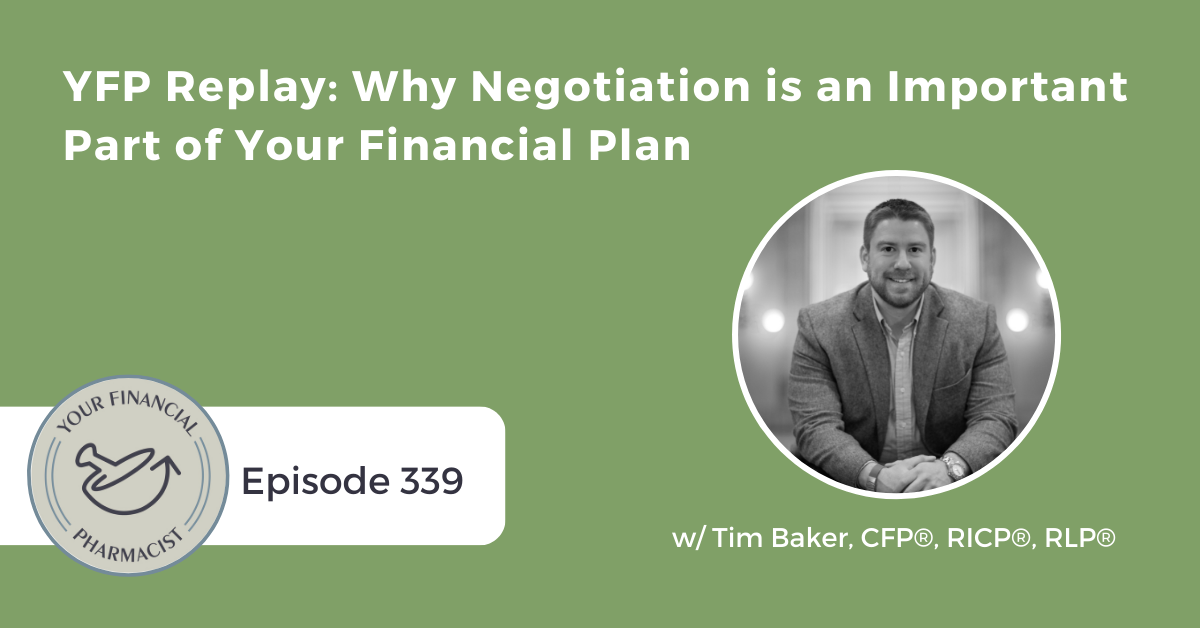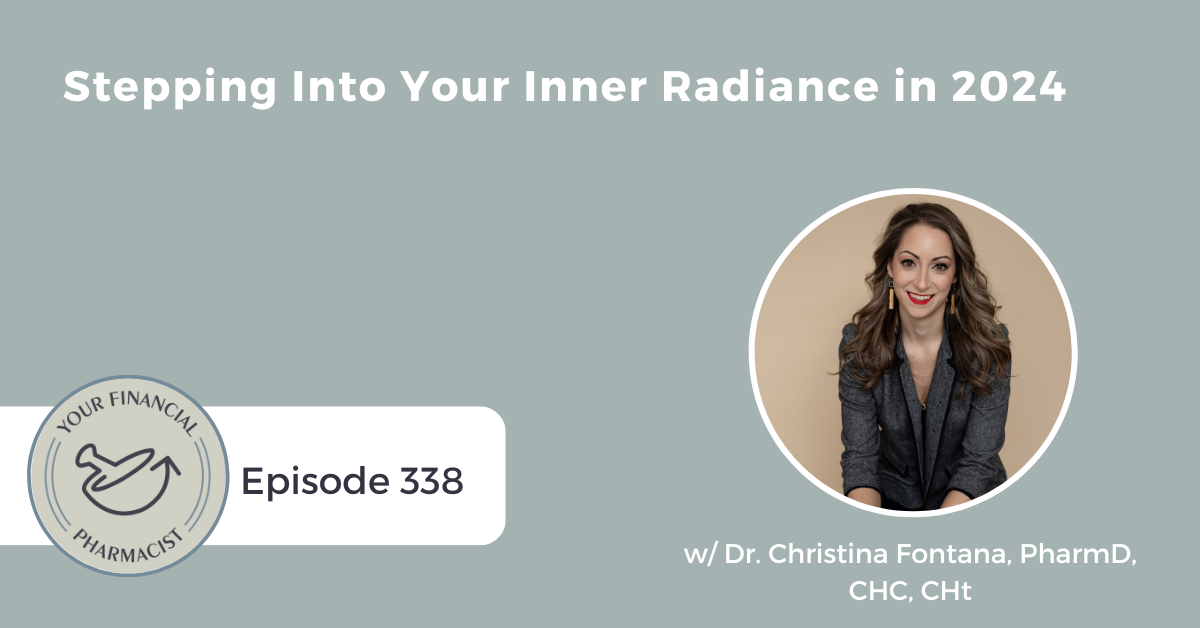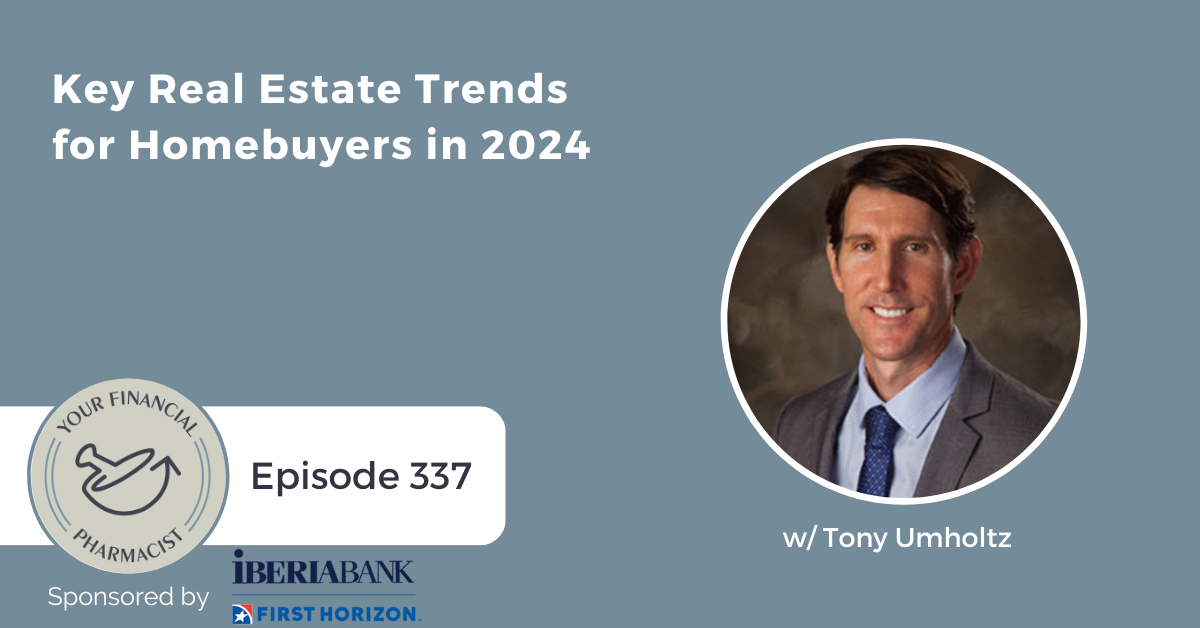Tim Ulbrich shares the importance of setting a budget for achieving your financial goals and five steps to help you get started.
Episode Summary
In this week’s episode, we learn all about one of the key first steps to mastering your money: creating a budget. You’ll learn how to implement a budgeting system that not only works, but is also enjoyable. Tim Ulbrich, YFP Founder and CEO shares a practical five-step process to help you get started. A budget isn’t a restrictive tool, but an important instrument that can empower you on your journey toward financial well-being and help align your money with your vision for a rich and fulfilling life.
About Today’s Guest
Tim Ulbrich is the Co-Founder and CEO of Your Financial Pharmacist. Founded in 2015, YFP is a fee-only financial planning firm and connects with the YFP community of 15,000+ pharmacy professionals via the Your Financial Pharmacist Podcast podcast, blog, website resources and speaking engagements. To date, YFP has partnered with 75+ organizations to provide personal finance education.
Tim received his Doctor of Pharmacy degree from Ohio Northern University and completed postgraduate residency training at The Ohio State University. He spent 9 years on faculty at Northeast Ohio Medical University prior to joining Ohio StateUniversity College of Pharmacy in 2019 as Clinical Professor and Director of the Master’s in Health-System Pharmacy Administration Program.
Tim is the host of the Your Financial Pharmacist Podcast which has more than 1 million downloads. Tim is also the co-author of Seven Figure Pharmacist: How to Maximize Your Income, Eliminate Debt and Create Wealth. Tim has presented to over 200 pharmacy associations, colleges, and groups on various personal finance topics including debt management, investing, retirement planning, and financial well-being.
Key Points from the Episode
- Budgeting for financial freedom. [0:00]
- Pharmacist financial success and budgeting. [3:51]
- Financial health check and budgeting. [7:32]
- Setting a financial vision and budget. [11:40]
- Budgeting methods for personal finance. [16:04]
- Budgeting and financial planning. [20:54]
- Budgeting and financial planning for pharmacists. [26:06]
Episode Highlights
“So I think it’s safe to say that most pharmacists didn’t spend six to eight plus years training to get into this profession, to work hard to find themselves living paycheck to paycheck.” – Tim Ulbrich
“So, if we can identify in advance what our goals are, and we can identify how much we have to allocate towards those goals, then the next step we’ll talk about is how to actually make sure we distribute them accordingly. All the sudden, we’re thinking in a way that we are pre funding our goals, right really important, rather than waiting to see what’s left over at the end of the month.” -Tim Ulbrich
Links Mentioned in Today’s Episode
- The Millionaire Next Door By Tom Stanley
- Your Financial Pharmacist Financial Fitness Test
- YFP Budget Template
- YFP Episode 341
- Budgeting Blueprint Webinar
- YFP 341: 5 Financial Moves to Make in 2024
- The Millionaire Next Door by Dr. Thomas Stanley
- Subscribe to the YFP Newsletter
- YFP Planning
- Your Financial Pharmacist
- YFP Disclaimer
- Tim Ulbrich on LinkedIn
- Your Financial Pharmacist on Facebook
- Your Financial Pharmacist on Instagram
Episode Transcript
Tim Ulbrich 00:00
Hey everybody, Tim Ulbrich here and thank you for listening to the YFP Podcast where each week we strive to inspire and encourage you on your path towards achieving financial freedom. This week, I’m digging into how you can develop a budgeting system and process that works and is one that you don’t hate. During the episode, we’re walking through five steps that you can follow to implement your own budget. But before doing that, we’ll discuss why it’s crucial to do a financial vitals check along with some vision setting to get clear on what it looks like to be living your rich life.
Tim Ulbrich 00:32
Alright, YFP community, I’m really excited to invite you to our next webinar on March 7, at 8:30pm/Eastern: Budgeting Blueprint, What Zero Based Budgeting Is, Why It Works and How to Start One. This webinar is different than webinars we’ve done before. Not only am I gonna dive into the ins and outs of the zero based budget and the power behind assigning each dollar a job, but I’m going to be doing a live demo of a zero based budget using the YFP budget template. And we’re going to be anonymously featuring real pharmacists’ budgets for you to see. So here’s the deal. First, I want you to register for the webinar. It’s free, visit yourfinancialpharmacist.com/budgetwebinar to save your seat. Again, that’s yourfinancialpharmacist.com/budgetwebinar. Second, we’re gonna be giving away three $50 amazon gift cards to pharmacists who submit their budget to be featured and who attend the webinar live. Here’s how you can do that: you go to download your FREE zero based budgeting template at yourfinancialpharmacist.com/budget again, yourfinancialpharmacist.com/budget, then go ahead and fill out your budget with your numbers. If you’ve never used a zero based budget before, don’t worry instructions are included in the template that will help you walk through the process. Make sure to save your budget, send us an email with that budget attached at [email protected]. And make sure to include the word “budget” in the subject line so we can quickly identify your template. In the email, I would love for you to also share any additional information that would be helpful for me to know, whether you’re a single income earner, whether you have dual incomes in the household, if you have any children, where you live. And of course, if you have any other questions that you’d like me to answer as it relates to your budget template. Then make sure to attend the webinar live for your chance to win one of the three $50 amazon gift cards. If you don’t want to turn your budget, no problem make sure to register for the webinar and we’ll send you the replay if you can’t join us live. Can’t wait to see you there and see the real life budgets from pharmacists in the YFP community.
Tim Ulbrich 02:37
Hi guys, Tim Ulbrich here. This week, we’re gonna be talking all about how to develop a budgeting system that works and hopefully is one that you don’t hate. Now if we’re being honest with ourselves, who gets a little nauseous when the topic of budgeting comes up? I mean, besides the future financial nerds out there, not many are a fan of the whole budgeting thing. Quote, “It takes too much time.” “I already know how much I spend.” “I don’t know how to make one and follow it.” “I’m afraid of what I might find when I track my expenses.” “I don’t like to be so restricted.” “I make enough money so I don’t need a budget.” These are just some of the most common reasons that I hear for all of the hate surrounding budgeting. So in that light, what if we thought of the budget instead as a mechanism by which we achieve our financial goals? It’s simply the roadmap. It’s the execution plan that we have for the vision for living our rich life. It’s the way that we’re going to achieve what we set out to achieve. Now what are the most common things I hear pharmacists say is, “Tim, I make a great income. But I don’t feel like I’m progressing financially.” And one of the greatest threats to a pharmacist long term financial success is believing that a six figure income equals financial success. That mindset I can guarantee you will hinder progress. And here’s why if you take the average pharmacists salary, a reasonable take home pay after taxes after health insurance premiums after any type of employer retirement contribution is about $7,000 per month, right, give or take. And if you assume the average student loan debt on a 10 year standard repayment, plus let’s just say a $400,000 home and interest rates today that adds up to about $4,500 per month or 65% of a pharmacist take home pay. Let me say that again. Between the average student loan debt and a $400,000. home on a 30 year mortgage. Right. I know some people live in higher cost living areas, some people live in lower cost of living areas. That adds up to about $4,500 per month of committed expenses or looking at it another way about 65% of that take home pay number that I just mentioned. That means we have about $2500 left each month for everything else, right all the other home related costs, property taxes, homeowners insurance, upkeep, of course food, clothing, car payments, gas, other debt payments, insurance premiums, additional savings, and not to be forgotten the more enjoyable discretionary expenses like vacation, experiences, eating out, giving, and so forth. So I think it’s safe to say that most pharmacists didn’t spend six to eight plus years training to get into this profession, to work hard to find themselves living paycheck to paycheck. Now, obviously, some pharmacist households have more than one income, so we have to factor that in. But regardless, we can see that the take home pay of a pharmacist only goes so far. And that’s why it’s critical that we shift the mindset that pharmacists make a great income. Yes, it’s a good income, one that is more than $50,000 higher per year than the average household income in the United States. So it’s a good income, objectively speaking. And so it’s a tool and it’s a pretty good one at that. But without a plan, it is going to have significant limits. So shifting your mindset around how much you make, and how far that income will go is the most important thing that you can do for your financial plan. Why? Because everything else will flow from that mindset, how you save, big purchase decisions, how you handle your debt, ideas for growing your income, and so on. So with that in mind, with the plan that we need to have one, right, we need to have some direction to make sure that we’re achieving our long term goals.
Let’s talk to you five steps to developing and automating a budget that works and hopefully is one that you don’t hate. Step number one is we have to do a financial vital check. Alright, before we get into the vision, before we get into the budget, we have to assess where we are at today. And sometimes this is painful. Sometimes this is exciting, right? Depending on the progress that we’ve made thus far. We need to really honestly assess are we on track? Are we ahead? Are we behind? And what does that even mean? And we don’t want to start running forward until we know where we’re at. And we want to find out what path we want to be running on. And a great starting point, certainly not the only place to be but a great starting point for the financial binos check is to really be tracking your net worth on a regular basis. Now, if you’ve been listening to the show, you’ve heard me talk about net worth many times before. Net worth is simply your assets or what you own, minus your liabilities or what you owe. And as I’ve shared often in my journey, paying off $200,000 of student loan debt and coming out of a significant amount of debt really into a period of trying to grow that net worth. This was a significant part of our journey, really shifting that mindset from income to being a tool, right income not being the end all to really being able to move that income to growing assets, paying down liabilities, and therefore growing net worth.
Now Dr. Tom Stanley in the book, The Millionaire Next Door, which if you haven’t read before, I’d highly recommend it. He says that one of the reasons that millionaires are economically successful is that they think differently. One of the reasons that millionaires are economically successful is that they think differently. And part of what he’s talking about here is this concept of income versus net worth . They recognize that income is a tool, but income by itself does not mean financial success. Now, what should be our net worth? Right? That’s an interesting question, what should be our net worth? And of course the answer that is it depends. But Dr. Tom Stanley in the book, The Millionaire Next Door gives us a calculation for expected net worth. And he says that your expected net worth is your age times your gross annual income divided by 10.
For example, if we had a 45 year old pharmacists making $140,000 per year, if we took 45 as their age, we multiplied it by $140,000 of income, we divide that by 10. That’s $630,000 would be their expected net worth for that 45 year old pharmacist making $140,000. Now in addition to net worth, that’s just one calculation. We certainly don’t want to hang our hat on that. There are other areas inside of this financial vitals check that we should be thinking about. Things like, where are we at with the emergency fund? Is that a box you’ve already checked? Is that something we need to focus on? Perhaps you looked at that several years ago, and now we need to update that because expenses have gone up. So where are we at with the emergency fund? That’s one part. Do we have revolving credit card debt? If so, typically, because of where those interest rates are we going to focus on that before we look at other parts of the plan. Have we landed on, for those that have student loans, have we landed on an optimized student loan repayment strategy? Critically important, many different pathways we can go. We know that certain strategies can be more advantageous than others in terms of cash flow, what we pay out of pocket, potentially forgiveness. So have you critically evaluated your loan repayment strategy? Other areas of the financial vitals check are we set with things like own occupation, Long Term Disability Insurance, or for those that need life insurance, we have a good term life insurance policy that’s going to cover the needs that we have, are we on track with retirement savings? Right?
We’ve talked about all these topics on the show before these areas, why it’s important to start here with the financial vitals check is all of these areas are going to potentially impact cash flow, and give us insight into where we want to prioritize and focus with the budget because you’ll see here in a moment, then we talk about how to execute on the budget. One of the things we need to know is what are the goals that we want to include in our budget? What are we focusing on? What are we prioritizing on in doing this vitals check is going to help us in part, identify what those areas are. Now if you want more information on this concept of financial vitals checking, you want to do your own financial vitals check, we have a neat tool available for free. If you go to yourfinancialpharmacist.com/financial-fitness-test. That’s our financial fitness test, again, yourfinancialpharmacist.com/financial-fitness-test that will take you to a quick interactive tool, and it’ll help you identify what some of these areas are to focus on. Again, we’ll link a link to that in the show notes. So that’s step one, doing the financial vital check.
Tim Ulbrich 11:40
Step number two, again, we’re not even in the budget yet, right? Step number two is setting the vision. I firmly believe, we firmly believe, that without a compelling vision, the budget will feel restrictive, right. Without a compelling vision, the budget will feel restrictive. And I can almost guarantee you as well that you will run out of gas at some point in time, if you don’t have a compelling vision, only to find yourself and the whiplash between, in and out of being intentional with your finances. Like we tend to approach other areas of our life, right, such as fitness, such as our diet, and so forth. If we have a compelling vision, think of that as the engine for the financial plan, especially if you are in a season of grinding it out or cutting back, which hopefully is temporary. But especially in those seasons, we want to have a very compelling vision that’s going to drive us forward and keep us motivated. So first things first, what does your rich life look like? What does your, keyword there, your rich life look like? I love this quote quote from Roy Bennett. He says, “Dream your own dreams achieve your own goals. Your journey is your own and unique.” That’s so important here, when we think about setting the vision for living a rich life. When we talk about our financial plan and our goals. It’s so easy to get caught up into what are other people doing or the comparison game. What does it mean for your family to be living a rich life. If we can get clear on that -something we’ve talked about on this show before – that’s gonna help us really have a strong plan when it comes to how we’re not only going to implement the budget, but how we’re also going to be able to achieve other financial goals like long term savings, and retirement. Don’t underestimate this step. Step number two, setting the vision think of this really as the window in which we’re looking through as we’re making any of the individual financial decisions.
Tim Ulbrich 13:44
Alright, step number three, is I want you to track back your spending 90 days. So before we get into the spreadsheets, before we start to set the budget going forward, I want you to track back you’re spending 90 days right? This is the audit of the expenses to identify how have we been spending our money before we set what the goal is going forward. Now, this is really easy to do. Thankfully, in 2024. Many banks, many tools, software options that are out there, that we can quickly pull statements from credit cards, from debit cards, from various accounts, and be able to aggregate these and many of them even automatically will categorize them for you. Sometimes you gotta clean that up. But this is a process that we think is really important before we set the plan going forward. Now 90 days, I believe is an important window of time, because in any given month, right in any 30 day period, we can have some anomalies with the budget that might not be “normal.”, right to the month that we would have throughout the year. And so 90 days is going to help to average that out a little bit. That’s one of the reasons we want to look back 90 days but also by looking back 90 days we’re going to start to identify some patterns of things that we might want to adjust or at least be aware of as we set the budget and plan going forward. So that’s step number three is we’re going to track back 90 days categorize those expenses, really look at what is our spending patterns, what’s the spending behaviors? And there, we’re going to quickly identify what’s the difference between our expenses, and what’s the differences between our take home pay, right, and that’s going to help us identify what we have to work with for the budget.
Tim Ulbrich 15:21
Alright, step number four is then actually setting the budget. Now, this is intentional that we don’t start here, right, I firmly believe from experience from working with many pharmacists on this that if we start with a budget, we tend to lose that momentum that I’ve been talking about. And especially if we have two people that are working on this together, where maybe they’re not on the same page financially, we want to first get clear on the vision, right? If we can have the shared dreams, the shared vision, I’ll never say the budgeting process is easy. But it’s more palatable when we’re working then from that mindset where, okay, now the budget is simply the execution of the vision that we’ve agreed upon. Right. So we don’t want to start here with a budget.
Of course, there are many ways to budget, some of you might be familiar with budgeting methods, such as the 50,30, 20 budget, which is about 50% of your expenses should be for essential, or excuse me, 50% of your income for essential expenses, about 30% of your income for discretionary expenses, those are the things that are the nice to haves, but we could cut them if we needed to cut them, and then about 20%, that’s going to go towards savings or investments. So there’s different models and frameworks of that. But many of you may be aware of something like that. There’s also budgeting methods that are known as like the no budget budget, which simply means that you identify, you know, what are those critical expenses that you have to fund each month, and then you just don’t overspend your income beyond that, right. And so that’s a method that we see people that are a little bit further in their career, that have a more significant rhythm and cadence to what they’ve been doing over a long period of time. They have a good handle on their expenses and their goals and whether or not they’re on track, that might be something that they’re not tracking in such a granular way. Okay, so lots of different ways to budget I’m going to focus though not on the 50-30-20 budget, not on the no budget budget, I’m gonna focus on the zero based budget, because I believe that while this isn’t for everyone, I believe that for many people that are trying to get either on track, let’s say you’re just getting started in your career, and you’re trying to develop a system that makes sure you’re setting yourself up for a good long term plan and that you have a good foundation, I think this is a great way to get started. And then you can pull back over time, or for those listening saying, hey, maybe you need to get back on track, or I’ve kind of lost my way. And I want to have a season of really getting refocused. I think the zero based budget method can be a way to do that.
Now, as a reminder, if you want to download the YFP budget template, so you can work along side as you’re listening, hopefully, you’re not driving as you’re doing this, you can go to yourfinancialpharmacist.com/budget to get that Excel template for free. Okay, so inside of this step of the zero based budget, I’m gonna walk you through five steps of how to complete the zero based budget. Step number one is you have to know your take home pay. Now, as obvious as that sounds, this can be challenging sometimes, right, especially for folks that are just getting started. You know, I see this often from a transition where someone’s going from student to resident or student to fellow and then they’re going into the first job, right? There’s that change that’s happening, or individuals that are going from one income to two incomes in the household, that certainly can be a season of change as well, or for those those seen that variable income. Right? Whether that be you know, side hustle income, additional income, or you don’t work consistent salary types of positions. This can be sometimes challenging, but we have to know on average per month, and for those of you that have variable income, we want to be conservative in this estimate. We have to know on average per month, what is our take home pay, right? This is the amount that you’ll be working with each month to cover your expenses and to put to work to achieve your financial goals. The take home pay or net pay is the amount that shows up on your paycheck, every pay period after taxes after health care insurance premiums that you pay after any retirement contributions and any other deductions that are withdrawn from your base pay or your gross pay. Okay, so for students, any students that are listening, right, this could also potentially include things like student loan disbursement money, plus any earned income that you would have in internships and so forth. So that’s step number one is that we have to determine our take home pay.
Step number two is we then want to account for and subtract our necessary or essential expenses. Now, the definition of necessary can be debated but for the purpose of this activity, let’s include the following as necessary or essential expenses. These would be things like housing, transportation, food, utilities, insurance premiums -if that’s applicable-and any minimum payments on your debts that you need to make. Now in this step, consider your food expense as what you need as an essential right, anything else that would be dining out, we’re going to include in discretionary in step number three in this budgeting exercise. Okay, so that’s step number two is we account for all of our essential or necessary expenses. And we’re working down from our take home pay.
Step number three, then is we’re going to determine how much we spend on discretionary expenses. Think of discretionary expenses as the nice to haves, but in a true financial emergency, they could be cut, if you needed to cut them, right, these would be things like eating out, you know, trips, extra trips, or shopping, extra payments on debt, clothing, expenses, beyond the minimum, you know, housing upgrades, and so forth. Right, it’s very easy to justify any one of these as essential. So it’s important here to be honest with ourselves, when evaluating this category. If you have no idea how much you spend on these types of expenses in a month, a good place to start is to review these from again, as we did earlier, looking back 90 days to review what you’re spending in these areas in various statements and categorize these whether that’s credit card statements, debit card statements, whatever might be the source of those expenses. Now, I want to emphasize here that discretionary expenses are not bad, right in any way, shape, or form. I think sometimes we get to this step, and we start to have some self judgment, and a little bit of questioning, Well, should I be spending money here? Should it be spending money there? Discretionary expenses, and of themselves are not bad, we’re just separating them from essential expenses as we look at this exercise. In fact, they’re an important part a very important part of living the rich life that we want to live, right? Yes, we’ve got to pay down debt. Yes, we have to save and invest for the future. But we also want to enjoy some of these things along the way. So that’s step number three is determining how much to spend on discretionary.
Step number four, then, is calculating what we call disposable income. Remember, we started with take home pay, we subtracted essential expenses, we subtracted discretionary expenses. And now what we’re trying to determine is what is the disposable income. So this is the amount that we calculate by taking, again, the take home pay, subtracting essential and discretionary expenses. This number is the amount that you have to put towards other financial goals, whether that’s building an emergency fund, whether it’s saving for kids college, whether that’s additional retirement savings, down payment on a home, second property, whatever might be the case. So for example, if you have a take home pay of $7,000, you have necessary expenses of $3,000, discretionary expenses of $2,000, you would have leftover $2,000 of disposable income that we can identify and work with and put towards other goals. Now, why this budgeting method, I think works well and hopefully is one that you don’t hate is we are doing this proactively, before we actually earn the income. Right? We’re doing this proactively before we actually earn the income. So, if we can identify in advance what our goals are, and we can identify how much we have to allocate towards those goals, then the next step we’ll talk about is how to actually make sure we distribute them accordingly. All the sudden, we’re thinking in a way that we are pre funding our goals, right really important, rather than waiting to see what’s left over at the end of the month. And that is what we typically see is sure this takes time to get set up. But when we have this system humming, when we see that we have disposable income, or we thought about that to assign to our various goals, and we know that we’re funding those goals, we can really see some feelings of momentum and progress that are taking place. So that’s step number four, calculating your expense, disposable income.
And then step number five is allocating that disposable income to your goals, right. This is where I really feel like the magic happens: allocating your disposable income to your financial goals. And again, we’re doing this proactively before we earn the income, or at least preparing for this. And then once we earn the income, we’re going to allocate accordingly. So if the amount of disposable income, right, in step number four, when we calculated that disposable income, if the amount of that disposable income isn’t enough to meet the goals that you’ve set and the timeframe that is desirable to you, or you find out that you have a deficit here, well, this is where really where the rubber meets the road. We’ve got some work to do. Right, we’ve got two options. We can adjust our goals, I guess three options, we can adjust our goals, we can cut our expenses, or we can try to grow our income and perhaps it might be a combination of those three, but this is really where we shine a light on the reality of where we are at and so often with the financial plan. The stress comes from living in the dark, right wondering, I hope, I wish, I dream are we going to be able to do this? And we’re going to be able to do that? Really, this system is telling us where are we at? And what are the areas that we want to focus on? And what are the dollars that we have available to do that if we can’t meet those two things? What adjustments do we need to make? Do we need to adjust our goals? Do we need to cut our expenses or, and or are their options to grow our income? Now, the reason why this is called a zero based budget is because at the end of step number five, where we’re allocating our disposable income to our goals, we should have “spent”, “spent” because we’re doing this proactively, our entire income, meaning that every dollar has been assigned, and we have a $0 balance remaining, right, because we’ve allocated every dollar to essential expenses, discretionary expenses, and then ultimately, to the goals that we’ve determined are most important.
Alright, so those are the five steps of creating the zero based budget. Now, if we zoom back out, remember, where did we start? We started with doing a financial vitals check. Where are we at today? What what is our net worth position? What are the areas of the financial plan that we want to focus on? We then talked about setting the vision, right? What does it mean, for us? Our unique plan and vision for living a rich life? How are we spending our money? How are we spending our time? We then talked about tracking back 90 days, so we can get an idea of what our spending is in various categories of the budget on average each month. And then we talked about setting the budget, right. And that was the five steps I just reviewed with a zero base budget.
Tim Ulbrich 26:31
Now the final step of all this part number five years really tracking and automating this system. Now how you choose to track this really doesn’t matter to me, at the end of the day, it’s the system that works best for you. And is the system that is feasible for you to keep going, at least for the foreseeable future. So when I asked a group of pharmacists, hey, what system do you use to track? You know, some people use some of the fancy softwares and tools that are out there, such as YNAB, or Every Dollar, just a couple examples, some use a tool that’s provided to them through their bank or the credit card that they use. Most people I would say, use probably a Google spreadsheet or some type of Excel template. So how you track it to me, doesn’t necessarily matter. But the second part of this final step, right, I mentioned, track and automate. Track and automate when it comes to automating your financial plan. It is so obvious, so effective, so easy to implement, but so many people aren’t optimizing this.
Think of automation as the mechanism by which you’re going to put your budget that we just said, we’re going to put this to work for us each and every month, because we’ve already done the hard work to proactively define what are our goals? And how are we going to prioritize and fund those goals. Now, I cover this in detail at length in Episode 341, where I talked about five financial moves to make in 2024, I talked about the concept of automation, I talked about exactly what the system looks like for Jess and I and our own financial plan. So make sure to go back and listen to that and how you can begin to implement automation as a part of your financial plan. Alright, so there you have it. Five steps that you can use to implement a budgeting system and process that not only hope, hopefully helps you achieve your financial goals. But I also hope makes this topic just a little bit more palatable. So we talked about the importance of doing that financial vital check, setting the vision, tracking back 90 days, setting the budget, and then developing a process to track and automate that along the way.
Alright, as we wrap up today, an important reminder about our webinar coming up on March 7 at 8:30pm/Eastern, Budgeting Blueprint, What Zero-Based Budgeting Is, Why It Works, and How to Start One. I’m really excited to walk you through in a visual manner how you can implement your own zero based budget as well as to anonymously feature other real pharmacists’ budgets for you to see. So to get started, you can register for the webinar for free again, you visit yourfinancialpharmacist.com/budgetwebinar again that yourfinancialpharmacist.com/budgetwebinar to save your seat. We’re gonna be giving away three $50 Amazon gift cards of pharmacists who submit their budget to be featured and who attend the webinar live. So as a reminder to have your template, your budget template featured, you can download that free zero based budget template yourfinancialpharmacist.com/budget, fill it out with your own numbers, send it back to us attach it [email protected], in the subject line make sure you note budget and then if you have any questions in your own budget template you want me to address during the webinar make sure to include those in the email as well. Alright, thanks so much for listening to this week’s episode of the YFP Podcast. We’ll catch you again next week. Take care.
Tim Ulbrich 29:51
As we conclude this week’s podcast and important reminder that the content on this show is provided to you for informational purposes only and is not intended to provide and should not be relied on for investment or any other advice. Information in the podcast and corresponding material should not be construed as a solicitation or offer to buy or sell any investment or related financial products. We urge listeners to consult with a financial advisor with respect to any investment. Furthermore, the information contained in our archive newsletters, blog posts and podcasts is not updated and may not be accurate at the time you listen to it on the podcast. Opinions and analyses expressed herein are solely those of Your Financial Pharmacist unless otherwise noted, and constitute judgments as of the dates published. Such information may contain forward looking statements, which are not intended to be guarantees of future events. Actual results could differ materially from those anticipated in the forward looking statements. For more information, please visit yourfinancialpharmacist.com/disclaimer. Thank you again for your support of the Your Financial Pharmacists Podcast. Have a great rest of your week.
Current Student Loan Refinance Offers
Note: Referral fees from affiliate links in this table are sent to the non-profit YFP Gives. | Bonus | Starting Rates | About | YFP Gives accepts advertising compensation from companies that appear on this site, which impacts the location and order in which brands (and/or their products) are presented, and also impacts the score that is assigned to it. Company lists on this page DO NOT imply endorsement. We do not feature all providers on the market. |
$800* Loans* ≥150K = $800 100-149K = $450 <100K = $350 | Variable: 5.28%+ APR (with autopay)* Fixed: 5.28%+ APR (with autopay)* *All bonus payments are by gift card. See terms | The "Kayak" of student loan refinancing, Credible displays personalized prequalified rates from multiple lenders | ||
$750* Loans ≥150K = $750* ≥50K-150k = $300 | Fixed: 5.49%+ APR (with autopay) | A marketplace that compares multiple lenders that are credit unions and local banks | ||
$500* Loans ≥50K = $500 | Variable: 4.99%+ (with autopay)* Fixed: 4.96%+ (with autopay)** Read rates and terms at SplashFinancial.com | Splash is a marketplace with loans available from an exclusive network of credit unions and banks as well as U-Fi, Laurenl Road, and PenFed |
Recent Posts
[pt_view id=”f651872qnv”]

